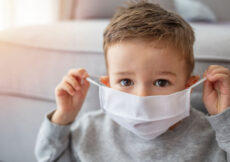Omega-3 fatty acids are essential fatty acids considered beneficial for heart health. They may reduce the risk of many other disorders such as diabetes, stroke, arthritis, asthma, psychological problems, and even some cancers. Omega-3 fatty acids are a type of polyunsaturated fatty acids (PUFA) and need to be obtained only from dietary sources (1).
The important long-chain omega-3 fatty acids are docosahexaenoic acid (DHA) and eicosapentaenoic acid (EPA) and are found in marine-based foods such as oily fish. Short-chain omega-3 consists of alpha-linolenic acid (ALA), which is mostly found in plant-based food such as flax seeds and chia seeds (2). This post tells you the importance, dosage, and food sources of omega-3 for kids.
Can Children Take Omega-3 Fatty Acids?
Yes, children can take omega-3 fatty acids by incorporating foods rich in these nutrients into their diet. Dietary supplements, such as fish oil supplements, are also available and may be used if diet alone does not provide recommended amounts. You should talk to your pediatrician or a dietician before giving omega-3 fatty acid supplements to your child (3).
What Are The Benefits Of Omega-3 For Children?
There are several therapeutic benefits of omega-3s. Omega-3 and omega-6 fatty acids are constituents of the cell membrane. They regulate cell membrane properties such as fluidity, permeability, and flexibility. These fatty acids also play a role in the function of the membrane-bound enzymes and receptors. All body parts are composed of cells, so anything that improves cell function benefits all systems in the body (4).
The regular consumption of omega-3s may provide the following benefits.
- Maintain cardiovascular health: Clinical studies have shown that omega-3s have the potential to reduce bad cholesterol and triglycerides in the body and increase high-density lipoproteins (HDL) or good cholesterol. The inclusion of these fatty acids from childhood may reduce the future risk of stroke, heart attack, and blood clots (5).
- Improve vision: High concentrations of DHA are found in retinal cell membranes. DHA and other omega-3s are required for normal development of vision. These fatty acids may be involved in the regeneration of the retinal pigment rhodopsin, which helps convert light received by the retina into visual images in the brain. Studies suggest that omega-3 deficiency may cause functional defects of vision (6).
- Help brain development: EPA and DHA help conduct important brain functions such as neuronal signal transmission, neural activity, gene expression, and myelination (maturation of some nerve cells where a covering of myelin forms around the axons that allows nerve impulses to travel faster). About 50% of the dry weight of an adult brain is composed of lipids, approximately 35% of which are PUFAs. DHA alone makes up 30% of the gray matter’s phosphoglycerides and is critical for proper nerve growth and brain health. Omega-3 supplementation may be beneficial to reduce the risk of cognitive and behavioral disorders such as attention deficit hyperactivity disorder (ADHD), autism spectrum disorder (ASD), and dyslexia in children (7).
- Reduce depression: Lower blood levels of omega-3 fats have been found among depressed individuals. Studies state that EPA may be potentially more effective in improving symptoms of major depressive disorder (depressed mood, irritability, fatigue, reduced pleasure, and difficulty concentrating) in children and adolescents (8).
- Improve immunity: Omega-3 fatty acids and their metabolites modulate various components of the immune response and show anti-inflammatory activity. This may be beneficial in controlling symptoms of allergic reactions and asthma in children (9).
- Reduce photosensitivity: PUFAs, especially EPA, may reduce UV-induced skin inflammation, such as sunburns, and protect against UV radiation-induced immunosuppression, cancer, skin aging, and photosensitivity reactions (10).
What Are The Sources Of Omega-3 Fatty Acids For Children?
Children may get their daily requirement of omega-3 fatty acids from naturally available foods, fortified foods, or an omega-3 fatty acid supplement (11).
- Fish oils are the major sources of EPA and DHA. They are mostly obtained from cold-water fatty fish such as salmon, mackerel, tuna, and sardines.
- Children may get ALA from various nuts and seeds, such as flaxseeds, chia seeds, and walnuts. Other sources include plant oils such as flaxseed oil, soybean oil, and canola oil.
- Fortified food includes certain brands of yogurt, juices, milk, soy products, and cereals.
- Children may take dietary supplements, including fish oil, krill oil, cod liver oil, and algae oil, to meet their recommended daily needs for omega-3 fatty acids.
What Is The Recommended Dosage Of Omega-3s In Children?
Below is the age-appropriate dosage of omega-3s for children as recommended by experts (11) (12).
|
Age |
Boys |
Girls |
|
1-3 years |
0.7 grams/day |
0.7 grams/day |
|
4-8 years |
0.9 grams/day |
0.9 grams/day |
|
9-13 years |
1.2 grams/day |
1.0 grams/day |
|
14-18 years |
1.6 grams/day |
1.1 grams/day |
Are There Any Side Effects Of Omega-3s?
The U.S. Food and Drug Administration (FDA) does not recommend consuming more than five grams per day of EPA and DHA combined from dietary supplements and food sources. Side effects of omega-3s, even within safe dosage, may occur in some individuals but are usually mild and may include the following (11).
- Unpleasant fishy aftertaste in mouth
- Bad breath
- Stomach upset
- Heartburn
- Nausea
- Diarrhea
- Headache
- Smelly sweat
There are plenty of options to make your child’s food rich in omega-3s by including fish, seeds, and seed oils. You may provide picky eaters omega-3 supplements after doctor consultation. Provide supplements in the dosage prescribed by the doctor and stop providing them if the doctor suggests it. Dietary sources of omega-3 are usually preferable. Check with your child’s healthcare professional or a registered dietitian to ensure your child gets adequate nutrients, such as omega-3 fatty acids, for overall growth and development.
References:
MomJunction’s articles are written after analyzing the research works of expert authors and institutions. Our references consist of resources established by authorities in their respective fields. You can learn more about the authenticity of the information we present in our editorial policy.
Recommended Articles
The following two tabs change content below.




































